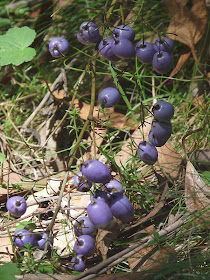This is the story - or rather two stories - of two very different groups of tropical rainforest ants, in two continents, which have in common only that they do remarkable things with leaves, and are the basis of two pretty good yarns.
 |
Leafcutter Ants, Yasuni National Park, Ecuador.
There are over 40 species of leaf-cutters in the genera Atta and Acromyrmex, found from southern North America through Central America to much of South America; the differences between the genera (not to mention the species) are really only available to laypeople with a good lens and an immobilised ant! |
 |
Green Tree Ant Oecophylla smaragdina, Litchfield National Park, south-west of Darwin, Northern Territory of Australia.
This species (as currently recognised) is found across the coastal tropics of Australia and through south-east Asia to India. Only the Australian ants have the green abdomen; elsewhere they are known as Weaver Ants.
There is also an African species, O. longinoda. |
Anyone familiar with the Australian tropics is very wary of Green Tree Ants; it is easy to inadvertently annoy them by leaning on their tree, and it's something you don't do twice. They don't have a sting, but they can bite hard enough to break the skin - after which they make sure they have your attention by spraying the wound with formic acid. It works too. On the other hand there seems to be no consensus about the stinging capabilities of the Leafcutters; different sources are equally adamant that they either do, or cannot, sting - perhaps it varies between species, or genera. There seems to be an agreement that they can bite however, though I've never had a problem with them, and the lodges in the Amazon which have trails of them on the paths don't see the need to warn guests about them.
They both utilise leaves, but in entirely different ways and for quite different purposes. The Green Tree Ants glue living leaves to make a magnificent nest.
 |
| Green Tree Ant nest, Darwin. The 'glue' can be seen as white material at the bottom of the nest. |
I've never seen the beginning of construction, but it's commenced by a few ants reaching across from one leaf to another to pull them together by sheer force. If the process looks like being a success, more ants join in - the more ants that are involved, the more likely it is that others will assist. If the gap between leaves is too wide the ants will form a living chain to bridge it. Once the leaves are in contact something even more remarkable happens. Other workers bring mature larvae, and with their antennae signal them to start releasing their silken threads from glands below their jaws; they move the larvae back and forth like glue guns.
A colony may number half a million ants, and maintain well over 100 nests in 20 or more trees. Green Tree Ants are voracious scavengers and hunters, streams of workers bringing back a variety of animal food for the queen and larvae; workers lay chemical trails to lead others to a good source.
 |
| Green Tree Ants dismembering a dragonfly, Litchfield National Park. |
Leafcutter ants on the other hand do not eat meat - but despite the evidence of our eyes, they do not eat leaves either!
 |
Leafcutter Ant trail, Manu, Peru.
These trails of ants carrying leaf segments above their backs as long as the sun lasts
are an integral part of South American rainforests. |
Given their ability to cut leaves all day into manageable pieces, it's not surprising that they're reputed to be able to give a respectable nip if molested. The leaf material is taken to the nest, cleaned and taken to the underground fungus farm, where they are used to feed a remarkable species of fungus, which has lived in ant nests for so long that it has lost the power to produce spores to reproduce (according to at least
one source anyway). The entire ant colony lives on the nutritious fungus.
 |
| Nor do all leafcutters restrict themselves to leaves! |
Some plants produce leaves which are inimical to the ants, which avoid these trees. If they do bring an undesirable leaf home they are able to monitor the fungus' reaction and remove the offending greenery again.
The nests are enormous and may cover tens of square metres of forest floor, which the colony keeps clear of vegetation.
 |
Leafcutter Ant nest, Manu, Peru.
A big colony can house millions of ants. |
When a queen leaves to start a new colony she takes a fungal sample with her to start the new farm. These young queens emerge in vast numbers, a resource large enough in Ecuador to attract the Quechua people to collect them, wrap them in leaves, and sell them in markets.
 |
| Leafcutter Ant queen, Sacha Lodge, Ecuador. |
I am always fascinated by ants, but the activities of Green Tree Ants and Leafcutters constantly astonish me, and they are one of the first things I look out for when I get back to the tropics. If you've met them, I hope this brings back good memories; if you haven't, that's something for you to look forward to!
BACK ON SUNDAY



+Pindar+0908.jpg)


+close-up+Lake+Monjimup+0908.jpg)

+Moore+River+NP+0808.jpg)




+deformis+Alligator+Gorge+0807.jpg)

















































